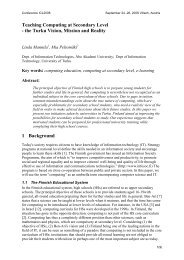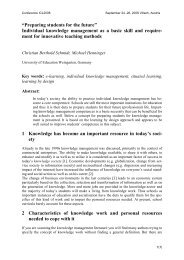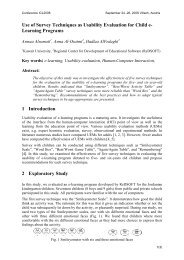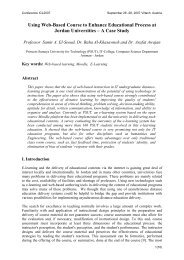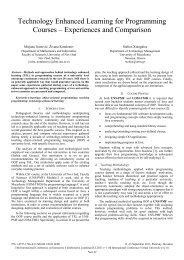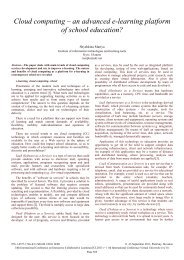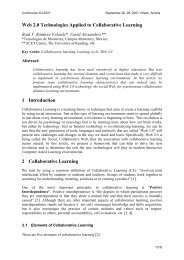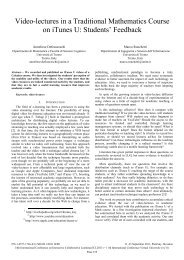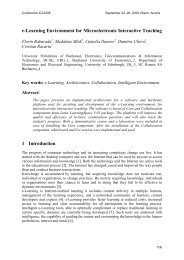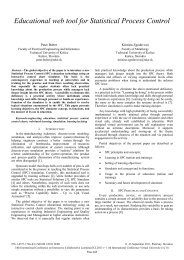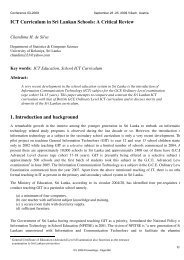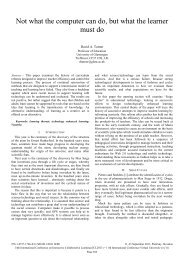Microcontrollers in Physics education: a circuit simulation ... - ICL
Microcontrollers in Physics education: a circuit simulation ... - ICL
Microcontrollers in Physics education: a circuit simulation ... - ICL
Create successful ePaper yourself
Turn your PDF publications into a flip-book with our unique Google optimized e-Paper software.
Conference <strong>ICL</strong>2010<br />
September 15 -17, 2010 Hasselt, Belgium<br />
Children are also taught (<strong>in</strong> theory) that: “Electric current exists only <strong>in</strong> closed <strong>circuit</strong>s.<br />
Therefore, if the switch is off the <strong>circuit</strong> opens, and although a battery is connected to the<br />
<strong>circuit</strong>, there is no forced movement of electrons. Consequently, when the <strong>circuit</strong> opens the<br />
electrons move randomly and slowly (i.e. thermally) and the light bulb does not illum<strong>in</strong>ate”.<br />
In the emulator, <strong>in</strong> case the switch is open, no mater if the battery is connected to the device<br />
or not, the LEDs spark randomly, and the light bulb does not illum<strong>in</strong>ate. Incidentally, due to<br />
the idiomatic use of the everyday language <strong>in</strong> Greece, the phrase “turn on the lights”<br />
translates (literally) to “open the lights”, which is of course very close to “open the <strong>circuit</strong>”,<br />
only to further confuse the students. The opposite phrase is used for turn<strong>in</strong>g the lights off,<br />
thereby mak<strong>in</strong>g the dist<strong>in</strong>ction between “scientific language” used at school, and “everyday<br />
language” used at home, f<strong>in</strong>al! This is precisely what the teacher tries to avoid as it re<strong>in</strong>forces<br />
the widely accepted op<strong>in</strong>ion amongst pupils, namely that science is irrelevant to everyday life.<br />
There is not much that an experienced teacher can do about it, except to learn to live with the<br />
problem and try to clear out any confusion <strong>in</strong> the best possible way.<br />
After all demonstrations have f<strong>in</strong>ished, all students (one pair at a time) experimented with the<br />
new device. They were asked to try all possible switch and battery comb<strong>in</strong>ations and carefully<br />
observe the results.<br />
For the AC case an ord<strong>in</strong>ary transformer that provides the <strong>circuit</strong> with 12V AC is used<br />
Students learn that “<strong>in</strong> A.C. current the move of electrons changes from clockwise to counterclockwise,<br />
and the frequency of the source will determ<strong>in</strong>e how many times per second this<br />
direction of movement changes”. For the purpose of the emulator presented here<strong>in</strong>, when the<br />
<strong>in</strong>put of the board detects high frequency alternat<strong>in</strong>g current, the frequency is reduced (by the<br />
embedded software program) so as the eye can see the change <strong>in</strong> the direction of the flow of<br />
electrons. The directions of the electrons move changes from clockwise to counter clockwise<br />
and the students can see clearly the change <strong>in</strong> the direction of the electron movement.<br />
Although the alternat<strong>in</strong>g current is the type most commonly used everyday, s<strong>in</strong>ce it is the<br />
current that electricity-supply companies provide, it is common practice to postpone the<br />
teach<strong>in</strong>g of it for a while, and to only <strong>in</strong>troduce it after the students had grasped the basic<br />
concepts of electric <strong>circuit</strong>s, and of DC electric current. The alternat<strong>in</strong>g current <strong>simulation</strong><br />
was not taught dur<strong>in</strong>g the trial teach<strong>in</strong>g sequence presented here, although there is a suitable<br />
video available onl<strong>in</strong>e. This was done for several reasons: a) AC current is even more difficult<br />
for the students to understand, because they cannot dist<strong>in</strong>guish the positive and negative pole<br />
and normally the electric current direction changes so quickly from clockwise to counter<br />
clockwise but the light bulb illum<strong>in</strong>ate cont<strong>in</strong>uously. And b) AC current was not taught for<br />
the time be<strong>in</strong>g (worried that this way one might encourage students to “experiment at home”<br />
us<strong>in</strong>g power from an ord<strong>in</strong>ary socket). This is because for this demonstration an ord<strong>in</strong>ary<br />
transformer that lowers the voltage to 12V AC should be used. The students participated <strong>in</strong><br />
the trial were young and not quite aware of the dangers <strong>in</strong>volved when us<strong>in</strong>g the 220-Volt<br />
sockets available at home. They are also unaware of the difference between the current<br />
available <strong>in</strong> the sockets and the one provided by the transformer.<br />
Therefore the teach<strong>in</strong>g of alternat<strong>in</strong>g current was postponed for a later time, <strong>in</strong> order to avoid<br />
students’ misunderstand<strong>in</strong>gs and prevent the acquir<strong>in</strong>g of misconceptions.<br />
4 The <strong>education</strong>al trial<br />
This is the first trial of this new device and, therefore, the knowledge rema<strong>in</strong><strong>in</strong>g to the<br />
students when this new teach<strong>in</strong>g procedure <strong>in</strong>corporat<strong>in</strong>g the new emulator device was<br />
<strong>ICL</strong> 2010 Proceed<strong>in</strong>gs – Page 414<br />
5(12)



